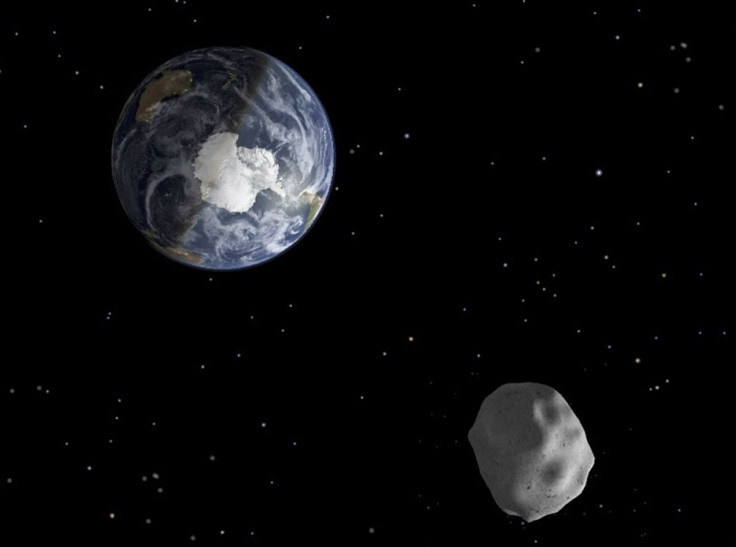Russia Meteor Not Related To 2012 DA14 Asteroid Close Encounter: NASA

After a schoolbus-size meteorite exploded over Russia on Friday, the public might feel a bit nervous about the fact that an asteroid half as long as a football field swung near Earth on the same day. But NASA scientists emphasize that the two events are unrelated.
The earliest analyses of the Russia meteor indicate it was about one-third the size of asteroid 2012 DA14 and traveling in a different direction than the larger object, which came within 17,200 miles of Earth without incident on Friday.
“It’s an incredible coincidence to have [these events] happening on the same day,” Paul Chodas, a research scientist in NASA’s Near Earth Object Program Office, said in a teleconference with reporters on Friday. But because the objects came toward Earth on completely different trajectories, Chodas said, “The fireball was not related to the DA14 asteroid in any way.”
The meteorite that injured more than a thousand people in the city of Chelyabinsk was traveling at nearly 40,000 mph when it smacked into Earth’s atmosphere. Because it broke apart, the meteorite was likely made of stony material instead of iron or other metals. Preliminary analyses indicate the meteorite was about 50 feet across and weighed about 7,000 metric tons.
Such a relatively large object striking the atmosphere at that speed released about 310 kilotons of energy as it exploded -- a force comparable with that of a nuclear bomb -- and generated a huge shock wave that propagated downward, according to NASA meteoroid researcher Bill Cooke.
“This shock wave struck the city below, causing windows to break, walls to collapse, and other minor damage,” Cooke said. “When you hear about injuries, those are undoubtedly due to the effects of the shock wave, not due to fragments striking the ground.”
The reason that the meteorite appeared to come out of nowhere is because it approached Earth on the daylight side of the planet, effectively cloaking it from telescopes.
Although it certainly seems out of the ordinary for a meteorite to explode in the air, it’s kind of surprising that it doesn’t happen more often. Earth is under a constant rain of rocks and particles from outer space, encountering about 80 tons of such material each day. Most of these are on the scale of a millimeter or two, but Earth does encounter a basketball-size object about once a day, and a car-size object every few months, according to Chodas.
Only a few objects survive the fall through the atmosphere without burning up.
“Events such as this occur approximately every 50 years,” University of Michigan earth scientist Joel Blum said via email. “The probability scales with the size of the objects, with larger impacts being less common.”
Since the Earth is 70 percent covered in water, the odds are good that most material will splash harmlessly into an ocean. But Russia, as the largest country in the world, has better odds of catching meteorites than other nations just due to its sheer size. The largest recorded impact in history, the Tunguska event in 1908, flattened around 850 square miles of trees in Siberia. Another notable impact came in 1947, when a 70-ton iron meteorite fell to Earth among the Sikhote-Alin mountains, also in Siberia.
NASA scientists think the Russia meteorite likely came from the asteroid belt between the orbits of Mars and Jupiter. This belt is full of material left over from the formation of the solar system, which would have likely formed another planet or planets, were it not for the gravitational influences of Jupiter and Mars.
Although telescopes weren’t able to detect the meteorite as it barreled down over Russia, another group of instruments was able to pick up the meteorite’s violent death: infrasound detectors. These instruments are spread across the globe in accordance with international nuclear test-ban treaties, listening for explosions in the sky.
The coincidence of the two celestial events is sure to spark discussion about how best to defend Earth from space objects. Asteroid mining company Deep Space Industries quickly called for establishing mechanical sentries in Earth’s orbit to look for threats from space. David Gump, CEO of the privately held DSI, said in a statement that putting 10 of the company’s FireFly spacecraft in position around the planet would cost less than $100 million and take less than four years.
“Astronomical observations are a good first step, but at Deep Space we believe we need get up close and personal,” DSI Chairman Rick Tumlinson said in a statement. “Then when these objects are identified, we can launch one or more FireFlies to intercept them, and give us close-up images so that we understand what we are dealing with.”
In another extraordinary coincidence, Earth’s close encounters with two space objects came around the same time that a United Nations-sponsored conference in Vienna is mulling the creation of an international asteroid-warning network.
© Copyright IBTimes 2024. All rights reserved.











